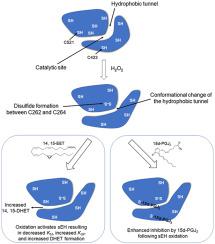Redox Biology ( IF 10.7 ) Pub Date : 2021-08-18 , DOI: 10.1016/j.redox.2021.102107 Rebecca L Charles 1 , Giancarlo Abis 2 , Beatriz F Fernandez 3 , Sebastian Guttzeit 3 , Roberto Buccafusca 4 , Maria R Conte 2 , Philip Eaton 1

|
Soluble epoxide hydrolase (sEH), an enzyme that broadly regulates the cardiovascular system, hydrolyses epoxyeicosatrienoic acids (EETs) to their corresponding dihydroxyeicosatrienoic acids (DHETs). We previously showed that endogenous lipid electrophiles adduct within the catalytic domain, inhibiting sEH to lower blood pressure in angiotensin II-induced hypertensive mice. As angiotensin II increases vascular H2O2, we explored sEH redox regulation by this oxidant and how this integrates with inhibition by lipid electrophiles to regulate vasotone. Kinetics analyses revealed that H2O2 not only increased the specific activity of sEH but increased its affinity for substrate and increased its catalytic efficiency. This oxidative activation was mediated by formation of an intra-disulfide bond between C262 and C264, as determined by mass spectrometry and substantiated by biotin-phenylarsinate and thioredoxin-trapping mutant assays. C262S/264S sEH mutants were resistant to peroxide-induced activation, corroborating the disulfide-activation mechanism. The physiological impact of sEH redox state was determined in isolated arteries and the effect of the pro-oxidant vasopressor angiotensin II on arterial sEH redox state and vasodilatory EETs indexed in mice. Angiotensin II induced the activating intra-disulfide in sEH, causing a decrease in plasma EET/DHET ratios that is consistent with the pressor response to this hormone. Although sEH C262–C264 disulfide formation enhances hydrolysis of vasodilatory EETs, this modification also sensitized sEH to inhibition by lipid electrophiles. This explains why angiotensin II decreases EETs and increases blood pressure, but when lipid electrophiles are also present, that EETs are increased and blood pressure lowered.
中文翻译:

可溶性环氧化物水解酶中的硫醇氧化还原传感器通过蛋白质内二硫键的形成实现氧化激活
可溶性环氧化物水解酶 (sEH) 是一种广泛调节心血管系统的酶,可将环氧二十碳三烯酸 (EET) 水解为其相应的二羟基二十碳三烯酸 (DHET)。我们之前表明,内源性脂质亲电子试剂在催化域内加成,抑制 sEH,从而降低血管紧张素 II 诱导的高血压小鼠的血压。随着血管紧张素 II 增加血管 H 2 O 2,我们探索了这种氧化剂对 sEH 氧化还原的调节,以及它如何与脂质亲电子试剂的抑制相结合来调节血管紧张素。动力学分析表明,H 2 O 2不仅增加了sEH的比活性,而且增加了其对底物的亲和力,提高了其催化效率。这种氧化活化是通过 C262 和 C264 之间形成内二硫键介导的,这一点通过质谱法测定,并通过生物素-苯胂酸盐和硫氧还蛋白捕获突变体测定证实。C262S/264S sEH 突变体对过氧化物诱导的激活具有抵抗力,证实了二硫键激活机制。在离体动脉中测定了 sEH 氧化还原状态的生理影响,并在小鼠中测定了促氧化血管加压药血管紧张素 II 对动脉 sEH 氧化还原状态和血管舒张 EET 的影响。血管紧张素 II 诱导 sEH 中二硫键的激活,导致血浆 EET/DHET 比率降低,这与对该激素的升压反应一致。尽管 sEH C262–C264 二硫键的形成增强了血管舒张 EET 的水解,但这种修饰也使 sEH 对脂质亲电子试剂的抑制敏感。这解释了为什么血管紧张素 II 会降低 EET 并升高血压,但当脂质亲电体也存在时,EET 会增加且血压会降低。











































 京公网安备 11010802027423号
京公网安备 11010802027423号